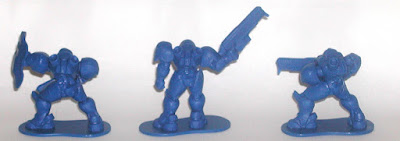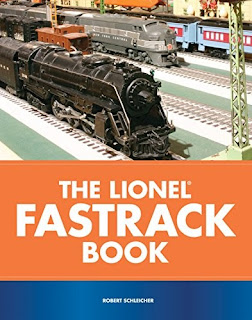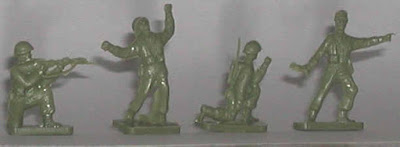The first time I entered a hobby shop, I was five or six years old. We were there because some older boys on the block had new toy soldiers. They were tiny. My mother had asked where they got them, and they told her about the hobby shop.
The hobby shop was a little storefront on Central Avenue. It was a small shop. There were display windows on either side and a door inside at the center. The windows displayed various models and trains and those tiny soldiers.
We entered a typical store of the time. There was a counter on one side with shelves behind it and some display items. The other side was a wall of wooden shelves with models and trains.
In one of the glass counters was a small display. I think it was white, or maybe a light gray or pale blue. The display was terraced, like steps. On each step were three or four tiny vehicles. They were a very dark color. Most were tiny tanks. Beside the display were boxes of the tiny soldiers.
To buy a tank, you had to tell the counter man which one you wanted by saying its number. He would look through stacks of gray boxes on shelves in the back counter. Each box had six or more tiny vehicles, each wrapped in a small plastic bag. Packed with each was decals: white stars for American vehicles, red stars for Soviets and Panzer Crosses for German tanks. The tanks were 25 cents apiece.
There were two kinds of soldiers in cardboard boxes with cellophane windows., They had a picture of soldiers on the front, and a list of the figures on the back. Only two kinds of soldiers were available. The green drab Infantry Combat Group looked like Allied soldiers. Blue-gray German Infantry had figures of World War II German troops. Each had 48 pieces. For a dollar, you could buy two tanks and a platoon of infantry.
There were other figures for model railroaders by the same company. I remember Farm Animals and Civilian figures in "HO / OO" scale. There was also a marching band set and British guardsmen.
At the time, ROCO only made a few different vehicles. I remember the US M47 and M48 Patton tanks, a US M4A1 Sherman, at least two different Panzer IVs, a German Panzer V "Panther", a Soviet JSIII "Stalin" tank, a 2 ½ ton truck and some other items.
We did not know much about tanks then, except for what we saw in movies, read in comics, or heard from older relatives who were veterans. Our play wars included a few tanks that were from a later era. We did not care. For little boys, close enough is good enough.
Of course, we could afford the little Roco tanks and Airfix soldiers. I remember one year when Halloween fell on a Saturday. My friends and I were out all day trick or treating. Along with candy and apples, some folks gave money. W e gathered nickels and dimes and pennies. One old woman even gave out quarters. That money was enough to buy some tanks at the hobby shop, which is just what we did. Then we returned to trick or treating to get more loot.

ROCO and Airfix continued to add new sets over the years. They all ended up at the little hobby shop. I remember the Airfix 8th Army, Afrika Korps, US Marines, Cowboys, Civil War guys, Indians and French Foreign Legion. Then came new sets with more detail, such as the Japanese Infantry, Arabs, Robin Hood, Romans and Ancient Britons. ROCO added more modern tanks and upgraded a few others, as well as expanding their World War II lines. In our youthful enthusiasm, we had toy-tank arms races where both sides had too many King Tigers and nothing lighter than a Sherman.
A couple of things changed the way we enjoyed our mini-tanks and min-men. One was a book titled War Games: Battles and Manoeuvres with Model Soldiers by Donald Featherstone. The book showed us a better way to play games with our tanks and troops.( A later book by Featherstone used specifications made to fit Airfix’s inventory of 1/76mm kits for a more advanced type of game. We loved it.)
Another change came over a decade later. Summer of 1972 was spent at the Jersey Shore. I made some friends and found a hobby shop: Air and Armor Hobbies in Belmar, NJ. We had a lot of fun, played our wargames and built models. At Continental Hobbies out by Freehold, I was introduced to the Roskopf mini-tanks. Of course, soldiers were the least of my concerns at the time. Like many youths my age, I would drop everything if a female entered the picture. (She was a skinny Irish chick and we had a lot of fun.) And so it was until mid-Autumn of that year, when I went into the Army....
My collection of tiny tanks and soldiers and other wargame figures were lost in the mid-1980s. A couple of disastrous moves followed by unexpected circumstances upset everything. I had little time for hobbies after that. Many other things needed my full attention. One needs a stable place to work with miniature hobbies. It took another ten years before I got back into them.
I have to admit a disappointment in miniature hobbies these days. There is little incentive for young people to get involved in them. Model kits are very expensive. So are trains. The little tanks sold by Herpa, many of which are reissued Roco models, are very expensive. While the Airfix soldiers are priced reasonably for these times, the tanks and other vehicles are not.
ROCO had competition. Eldon, UPC, Aurora and Marusan made kits that were pretty much knockoffs of Roco vehicles. They were all affordable. The same went for the Roskopf tanks. They were all priced fairly for the time. When I see the price of Herpa kits, I balk, Sure, some are updated and have extra detail. That tooling might have been expensive. However that may be, how does an item that went for 29 cents in 1966 sell for over $20 in 2016? And how are we going to attract young people to the hobby when a single piece costs more than one of their video games?
We need to bring back those competing kits!
One of the things this hobby gives is the satisfaction of doing it oneself. I remember how I felt the first time I did a full paint job and decals on a ROCO tank. That is just one of the satisfactions this hobby has. There was the fun of learning about the real vehicles and how they were used. More fun came by painting soldiers and arranging miniature units. There were also dioramas and little battlefields we made, using the old "Village in a Bag" houses. We learned to paint and assemble small things, and to use our creativity with tangible results.
The fellows running the old hobby shops were more than merchants. They knew their products and how to work with them. In our local shop, the owners showed us how to camo-paint our ROCO tanks and told us what paint set to buy. (Testor’s Military Flats). The same guys could tell you how to set up switches on an HO railroad, what track you needed to expand an HO slot car set, and what tricks to use building model kits. I can think of a few other shops offhand where the folks behind the counter could offer expert advice on using the shop’s products. Sadly, all of them are long gone.
I believe that one day, people will realize what they are missing and will again seek activities that require making something. At least, I hope so. The virtual world and video games are ethereal and intangible. People may again seek to make something tangible, They will want that which has physical reality. Likewise, I hope they regain the satisfaction of making something.. For us who know the pleasure of the job well done, the benefits are obvious. Perhaps one day young people will rediscover those benefits for themselves.
****
Most hobby shops were fun, but there were always an odd few where the owners were less than congenial. We called them "Hobby grumps" and "Hobby grouches". Those surly individuals acted as if customers were at worst a nuisance, at best an occupational hazard. Most of them also thought they were the best hobby dealers on Earth and deserved total customer loyalty. As soon as a competing shop opened close enough to them, their customers headed to the new place. Should any ever stop back in the grouch’s shop again, they would hear a derisive remark about being a disloyal customer or some such rubbish.
The hobby grumps were especially unfriendly to younger hobbyists. Instead of seeing children as the future of the hobby, they were rude. By the time those kids became older and had more to spend on hobbies, they were already someone else’s customers.
Fortunately for me, the folks who ran the hobby shop in my neighborhood were friendly to all of their customers. That inspired many to invest more interest in hobbies. Most shops were the province of good-natured fellows who were more than happy to share their expertise. That personal insight is something that cannot be gotten on the Internet. On the other hand, the grumps were a rare hazard in an otherwise pleasant field.























































